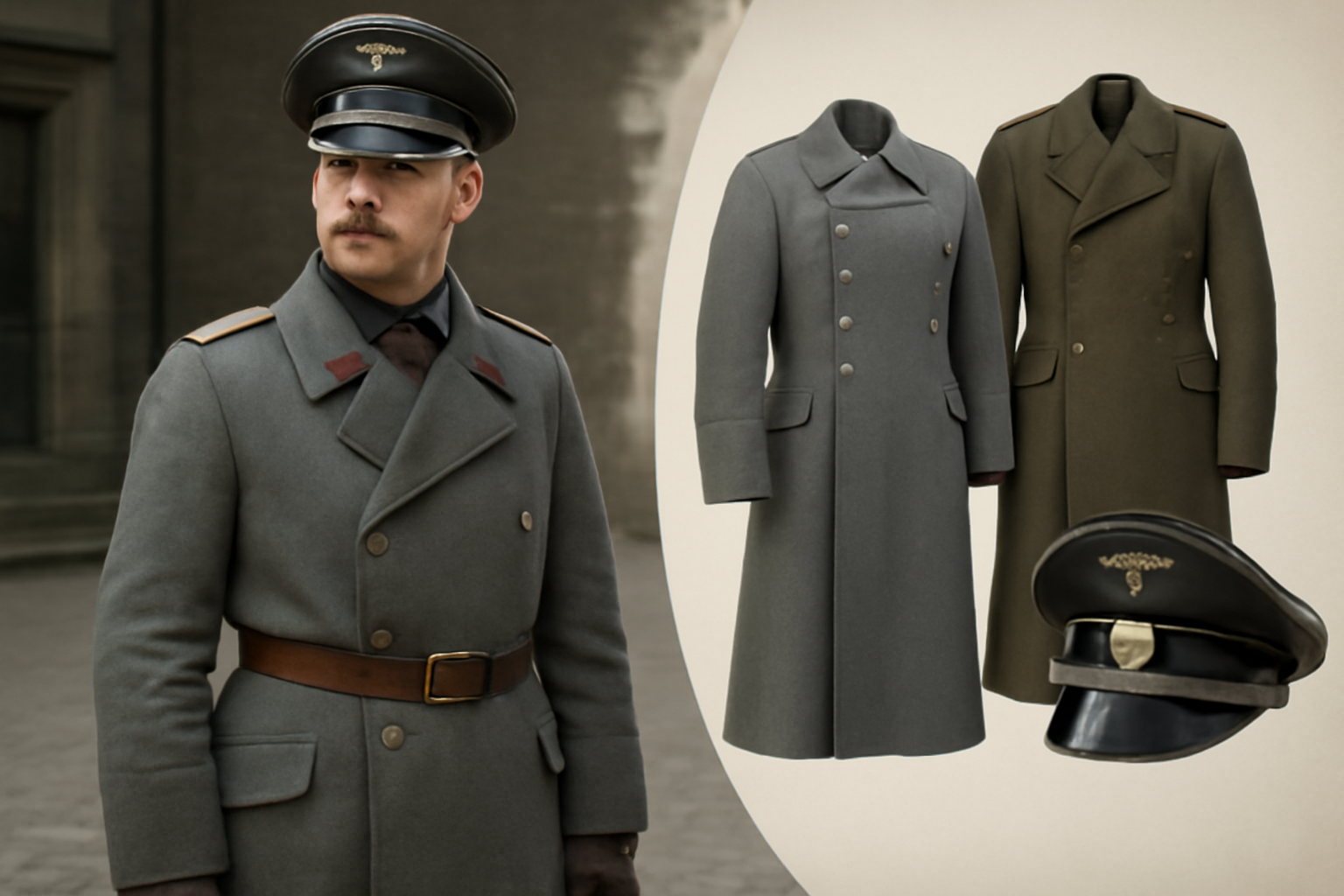
WW1 German Officer Uniforms: A Detailed Look at the Iconic WW1 German Greatcoat and its Evolution into WW2 German Military Wear"
Published on Jun 21, 2025
Introduction:
When studying the uniforms of history’s most intense conflicts, the German officer uniforms from World War 1 (WW1) and World War 2 (WW2) stand out for their distinctive designs, functionality, and impact on military fashion. One such key piece of military attire is the German greatcoat, which evolved throughout these two world wars. This article delves into the history and significance of the WW1 German officer uniform, with a spotlight on the iconic German greatcoat and how it laid the groundwork for its successor in WW2.
The WW1 German Officer Uniform: A Symbol of Power and Authority
The WW1 German officer uniform was designed to exude authority, discipline, and professionalism. It was a reflection of the German military's dedication to precision and efficiency. Officer uniforms were distinctively tailored, with particular attention given to the color, cuts, and the use of military regalia to signify rank and status.
A standout feature of the WW1 German officer uniform was the German greatcoat. This overcoat, designed to withstand the harsh weather conditions of the front lines, was a practical yet stylish piece of military gear. The greatcoat was made from heavy wool and featured a double-breasted front, high collars, and epaulettes. Its design not only provided warmth but also allowed for the easy display of insignia and medals, which were important symbols of honor in the German military.
The German Greatcoat: Essential Gear in WW1
The German greatcoat was more than just a piece of clothing; it was an essential part of the officer’s uniform during WW1. Its practicality in the trenches cannot be understated. The greatcoat offered warmth and protection against the brutal cold of the Western Front, where soldiers often faced sub-zero temperatures.
The coat was designed with function in mind. With its long cut, the greatcoat could be worn over other military garments, ensuring that the officer stayed warm while maintaining a professional appearance. The fabric, often dark grey or feldgrau (field grey), provided both camouflage and durability.
This combination of utility and design made the WW1 German greatcoat an iconic garment in military history. The high collars and distinctive buttons added a regal look that spoke to the German military’s prestigious status at the time.
The Evolution of the Greatcoat in WW2
As history progressed into the next global conflict, the WW2 German greatcoat maintained much of the original design but was updated for the changing needs of the German army. The WW2 greatcoat still featured the long, double-breasted cut, but there were some notable modifications. The coat became slightly shorter, as the officers had to adapt to more mobile warfare during WW2.
The woolen fabric was still favored, but newer materials, such as lined fabrics, were incorporated to improve insulation and comfort. While the WW2 German greatcoat retained its signature dark grey color, it was now accompanied by a greater variety of insignia, badges, and patches, all of which marked the officer's rank and division.
The German military needed to adapt to the new demands of modern warfare, and the greatcoat was an essential piece of that transformation. Although not as universally practical as in WW1, it was still an emblem of German military tradition.
The Role of the German SS Cap in Military Fashion
Alongside the greatcoats, one of the most recognizable pieces of German military attire was the German SS cap. Introduced by the Nazi regime during WW2, the SS cap was a distinct part of the SS uniform, separate from the general German army. This cap was made of black wool and featured a silver skull and crossbones emblem, symbolizing the death's head division.
The SS cap gained infamy for its association with the Waffen-SS, the combat branch of the SS. Its style was bold and direct, with sharp lines and a prominent visor. The cap became a symbol of the SS’s authority and discipline, contrasting against the more traditional and somewhat restrained uniforms of regular German officers.
The role of the German SS cap within the broader context of WW2 uniforms was significant in shaping military aesthetics, contributing to the eerie and intimidating reputation of the Nazi forces.
Why the WW1 German Officer Uniform and Greatcoat Remain Iconic
The WW1 German officer uniform and its most iconic piece, the greatcoat, remain symbols of a bygone era in military history. Their design influenced the development of military uniforms for years to come, not just in Germany but in other nations as well. The practical design, coupled with the strategic use of materials, made the greatcoat an essential item in the German military officer's wardrobe.
Furthermore, the WW1 German greatcoat had a lasting impact on the design of military overcoats in subsequent years, including the WW2 German greatcoat. Even today, military uniforms around the world have been influenced by the innovations and functional designs of the German officer uniforms from both World Wars.
Conclusion: A Lasting Legacy in Military Uniform Design
The WW1 German officer uniforms and German greatcoats played a crucial role in shaping military fashion during the early 20th century. From their initial design during WW1 to their evolution in WW2, the German greatcoat exemplified a combination of functionality, practicality, and status. While the SS cap became a notorious symbol during WW2, it also contributed to the overall transformation of military uniform aesthetics during this turbulent period.
Today, the influence of these uniforms is still felt in military design. Their lasting legacy serves as a reminder of the complex history surrounding military fashion and the role uniforms play in representing the power and structure of military forces. Understanding the evolution of German officer uniforms offers insights not only into the past but also into the ongoing role that military uniforms play in contemporary societies.
